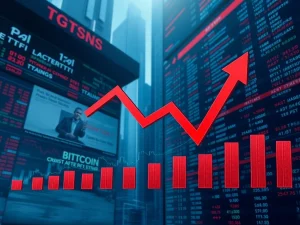Bitcoin Price: Unveiling the Crucial Uncertainty of US Debt Ceiling Increases

The cryptocurrency world is abuzz with speculation: will the proposed ‘Big Beautiful Bill’ and its massive $5 trillion increase to the US debt ceiling truly usher in a new era for the Bitcoin price? Many enthusiasts believe this fiscal maneuver could be a significant catalyst, potentially propelling Bitcoin to new all-time highs. However, a deeper dive into historical patterns and broader economic indicators suggests a more nuanced reality, challenging the direct causal link some eagerly anticipate. This article provides a comprehensive market analysis, exploring whether the optimism surrounding Bitcoin’s prospects in the face of escalating national debt is truly warranted.
Understanding the US Debt Ceiling and Bitcoin’s Past Performance
The recent advancement of President Trump’s ‘One Big Beautiful Bill’ through the Senate has reignited discussions about the US debt ceiling. This legislative action, proposing a substantial increase, aims to allow the government to meet its existing financial obligations. For Bitcoin proponents, such increases often signal potential currency debasement, making scarce assets like BTC more attractive.
- Historical Disconnect: While the narrative suggests a bullish outcome for Bitcoin following debt ceiling increases, historical data presents a less consistent picture. In fact, most past instances have seen bearish or flat performance for BTC in the subsequent six months.
- The June 2023 Anomaly: The June 2023 event stands out as the sole occasion where Bitcoin recorded gains post-debt ceiling resolution. This isolated incident makes it difficult to establish a reliable pattern.
- Pricing In Developments: Some argue that markets price in these developments in advance. However, Bitcoin’s relatively flat performance over recent months—holding steady around $105,000 despite widespread expectations of the debt ceiling increase—challenges this assumption. This resilience occurred even as economists projected government funds would deplete by mid-August.
The Impact of Monetary Policy on the US Dollar and Bitcoin
Beyond the immediate headlines of the US debt ceiling, the broader implications of fiscal and monetary policy are paramount. The nonpartisan Congressional Budget Office (CBO) estimates the proposed legislation will add at least $3.3 trillion to the federal deficit over the next decade. This substantial increase in debt, coupled with criticisms from financial experts like Sven Henrich regarding “modern monetary theory” (MMT) implications, shifts attention to the Federal Reserve’s actions.
- Interest Rates and Debt Servicing: If the US Federal Reserve maintains higher interest rates, the cost of servicing the national debt escalates significantly. This can create pressure on government finances and potentially lead to further expansionary policies.
- Looser Monetary Policy and the US Dollar: Conversely, a shift towards looser monetary policy, often involving lower interest rates or quantitative easing, could undermine the strength of the US dollar. A weaker dollar makes imports more expensive and can fuel inflation, traditionally seen as a bullish signal for alternative assets like Bitcoin.
- Treasury Yields as an Indicator: US 10-year Treasury yields serve as a crucial barometer of investor confidence. Higher yields typically reflect reduced confidence, as investors demand greater compensation for perceived risks. Historically, this indicator has shown a positive correlation with Bitcoin’s price, suggesting both tend to rise together. The recent observation of Bitcoin holding above $105,000 while the 10-year Treasury yield fell from 4.50% to 4.25% on June 6 hints at an early decoupling, where Bitcoin might be reacting to different market forces.
Bitcoin’s Role as an Alternative Asset Amidst Economic Shifts
The broader economic landscape suggests that markets are increasingly pricing in a weaker US dollar. This sentiment is evidenced by capital flows into assets traditionally seen as hedges against currency debasement, including equities, commodities, and Bitcoin itself. This trend highlights Bitcoin’s growing perception as a store of value, particularly among investors concerned about the long-term stability of fiat currencies.
According to analyses from sources like “The Kobeissi Letter,” the dollar’s perceived devaluation stems from several factors:
- Tariffs: Trade protectionist measures can impact global supply chains and currency valuations.
- US Deficit Spending Crisis: The persistent and growing federal deficit raises concerns about the government’s fiscal health and its ability to manage its debt burden.
- Pressure on the Fed to Cut Rates: Political and economic pressure on the Federal Reserve to lower interest rates can further weaken the dollar by reducing its yield attractiveness compared to other currencies or assets.
While Bitcoin’s resilience above $105,000 is notable, especially when compared to traditional safe havens like gold and the S&P 500, which are also approaching all-time highs, it remains premature to definitively declare Bitcoin a proven reserve asset. Its volatility, while decreasing, is still higher than established alternatives. The ongoing market analysis will be critical in discerning whether this is a temporary trend or a fundamental shift in asset allocation.
Actionable Insights for Investors
Given the complex interplay of fiscal policy, monetary decisions, and market sentiment, investors should consider a multi-faceted approach when assessing Bitcoin’s future performance:
- Monitor Federal Reserve Policy: The Fed’s stance on interest rates and quantitative easing will likely have a more direct impact on Bitcoin than the debt ceiling itself. A pivot towards looser monetary policy could indeed provide a tailwind for BTC.
- Observe Dollar Strength: Keep a close eye on the US Dollar Index (DXY). A sustained weakening of the dollar could signal capital rotation into alternative assets.
- Analyze Treasury Yields: The relationship between Bitcoin and Treasury yields, particularly any signs of decoupling, can offer insights into how the market perceives Bitcoin’s role as a hedge.
- Diversify and Educate: While Bitcoin offers unique potential, a diversified portfolio and continuous education on macroeconomic trends remain crucial.
Conclusion: Navigating Bitcoin’s Path Amidst Economic Crosscurrents
The passage of the ‘Big Beautiful Bill’ and the increase in the US debt ceiling represent significant fiscal events. While some Bitcoin advocates view these developments as clear bullish signals, a thorough examination of historical data and the underlying economic mechanisms reveals a more intricate picture. The direct causal link between debt ceiling increases and sustained Bitcoin price rallies is not consistently supported by past performance. Instead, Bitcoin’s resilience and potential future gains appear more closely tied to broader macroeconomic forces, particularly the Federal Reserve’s monetary policy and the perceived strength or weakness of the US dollar.
Ultimately, as investors seek refuge from potential currency debasement and navigate an an evolving financial landscape, Bitcoin continues to solidify its position as a compelling alternative asset. However, its trajectory will likely be determined less by singular legislative acts and more by the ongoing dance between global economic stability, central bank actions, and the persistent quest for sound money. Continuous, diligent market analysis will be key to understanding Bitcoin’s true role in this unfolding narrative.









